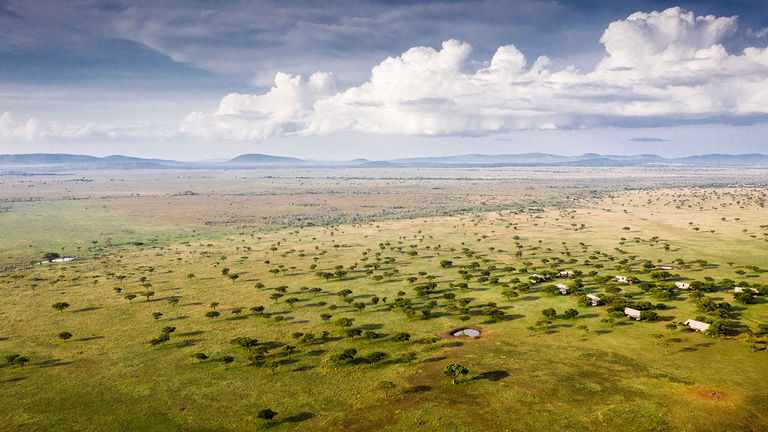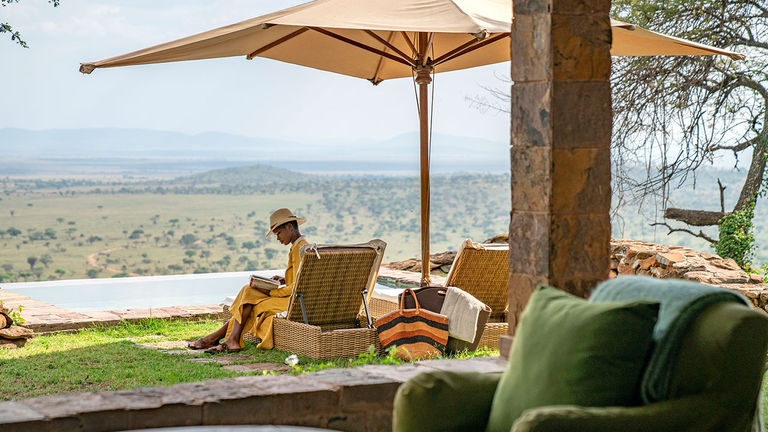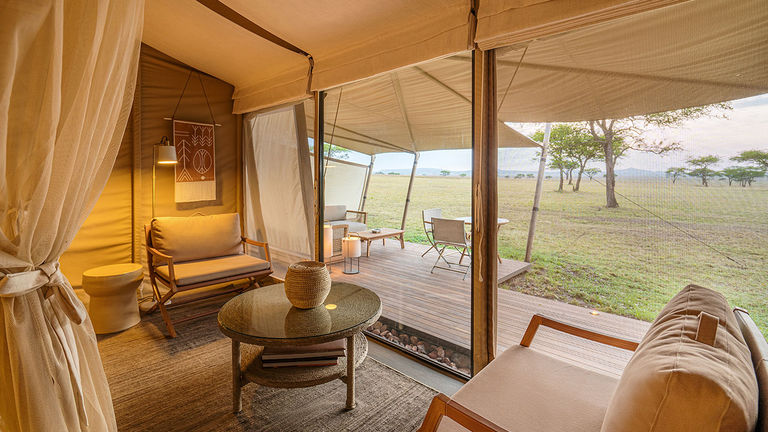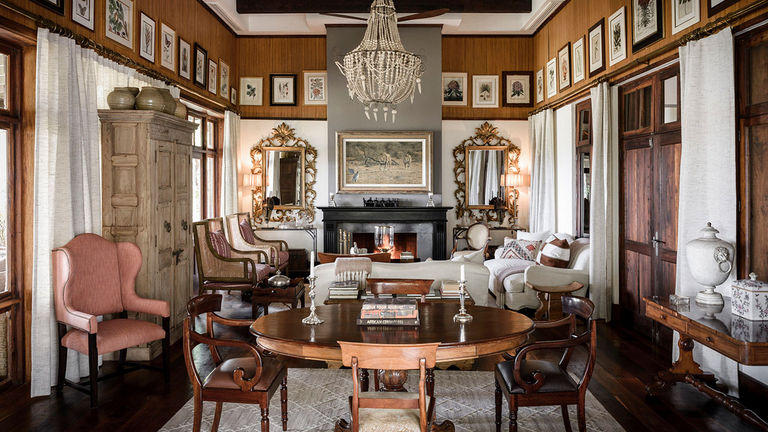It was just shy of 7 a.m. at Singita Grumeti, a private reserve located adjacent to Tanzania’s Serengeti National Park, and the day already showed great promise. A speck in the distance had revealed a pride of lions up close: Four cubs and a lioness devoured an ill-fated wildebeest, and eight more lions stood watch nearby.
Others had gathered, too. A tawny eagle and a pair of vultures circled the sky overhead, and a hyena, discreet behind tall grass, patiently waited her turn. Farther still, a black-backed jackal took stock of the grisly remains.
With the exception of my guide, Jeremiah Morris — a walking encyclopedia on Singita Grumeti’s indigenous biodiversity — there was not another human for miles.
 Grumeti Fund, in partnership with Singita, maintains the private Singita Grumeti reserve.
Grumeti Fund, in partnership with Singita, maintains the private Singita Grumeti reserve.
Credit: 2022 Singita
Viewing the scene from my game drive vehicle, I could hardly believe my good fortune. But there was much more to it than a stroke of luck: Nonprofit organization Grumeti Fund, in partnership with conservation and ecotourism brand Singita, is scrupulous in its protection of the reserve. It employs 165 dedicated staff to monitor the 350,000 acres, including 100 anti-poaching game scouts who comb the area for traps and snares fixed by poachers.
“When you protect the wildlife, you also nourish them,” Morris said. “Everything begins to thrive.”
When you protect the wildlife, you also nourish them. Everything begins to thrive.
When the Grumeti Fund began its conservation work in 2002, there were only five lions living in the reserve. Today, with less illegal activity, as well as increased jobs and scholarships made available for local communities, an estimated 300 lions roam the vast plains and grasslands. Despite being sought after for their ivory tusks, elephants have multiplied, too. (Discovering 15 of the gentle giants alongside a half-dozen baby elephants felt like the grandest of finales on my last day.)
My December 2021 visit to Singita Grumeti fell on the tail end of migration season, when 2 million wildebeest, zebras, gazelles and impalas famously make their way through the Serengeti and Kenya’s Masai Mara ecosystems in search of greener pastures.
 Singita offers five unique lodges in the Serengeti.
Singita offers five unique lodges in the Serengeti.
Credit: 2022 SingitaHundreds of these very animals served as an otherworldly backdrop to hot coffee and breakfast in the middle of a game drive — one example of Singita’s surprise bush experiences for clients. Presented at least once per stay, such an experience instead might be a sommelier-led wine tasting at sunset, or an elevated picnic featuring creature comforts such as pillows, books and games.
Singita Sabora Tented Camp
When I wasn’t chasing “the big five” animals on twice-daily game drives, I unwound in the lap of luxury. Reopened in September 2020 following a full redesign, Singita Sabora Tented Camp has ruined all future camping trips for me.
 Singita Sabora Tented Camp offers a high-end, but classic tented camp experience.
Singita Sabora Tented Camp offers a high-end, but classic tented camp experience.
Credit: 2022 SingitaA contemporary rendition of the classic tented safari (think muted colors and decorative accents in brass, leather and wicker), nine suites offer indoor-outdoor living spaces, a meditation deck, a dining area, a stocked pantry, a soaking tub and more. In respect to the environs, the property embraces sustainable materials and employs solar power, energy-efficient lighting and cross ventilation.
Elsewhere at Sabora Tented Camp is a fitness center, a swimming pool, a wellness space and dining areas enriched by exceptional cuisine. A particularly standout dinner highlighted Swahili fare (available upon request); to this day, I yearn for delicious Tanzanian pilau rice and plantain-based mtori stew.
Singita Sasakwa Lodge
To tap into Singita Grumeti’s full potential, however, I suggest booking clients at more than one of the five lodges. Each has its own flair, but impeccable service is consistent across the board. Although I was intrigued by Singita Explore, an exclusive mobile camp that follows wildlife activity, and Singita Faru Faru Lodge, which showcases an unobscured view of a bustling water hole, I closed out my trip with the old-world luxury of Singita Sasakwa Lodge. (The fifth property, Serengeti House, is perfect for a private group with up to eight guests.)
Emulating an Edwardian-era manor house, Sasakwa Lodge is a study in colonial opulence. Ten private cottages, each with a plunge pool, and a two-story villa (called Hillside Suite) comprise the sprawling property. There are also manicured lawns, a large infinity pool, a tennis court, a spa and upscale boutiques.
 Singita Sasakwa has an Edwardian-era aesthetic.
Singita Sasakwa has an Edwardian-era aesthetic.
Credit: 2022 SingitaMy spacious cottage embodied the quintessential East African safari for high society: a curated blend of ornate chandeliers and antique furniture juxtaposed with local artifacts and African textiles. It was easy to get swept up in the fantasy of it all, from taking leisurely soaks in a claw-footed bathtub to reading by a crackling fire, snuggled into a leather armchair.
As with any Singita Grumeti property, it’s recommended to eat and drink alfresco. And thanks to its lofty position atop Sasakwa Hill, Sasakwa Lodge lays claim to some of the most sought-after seats in all of the reserve. Still, no matter where clients find themselves at Singita Grumeti, it’s the incredible company they’ll keep — ostriches, impalas, warthogs, monkeys, giraffes and leopards, to name a few — that truly makes for the trip of a lifetime.
The Details
Singita